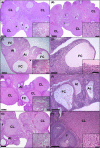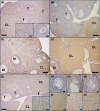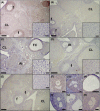Histopathological changes in androgenized ovaries are recovered by melatonin treatment
- PMID: 30256483
- PMCID: PMC6157297
- DOI: 10.1111/iep.12283
Histopathological changes in androgenized ovaries are recovered by melatonin treatment
Abstract
Nandrolone decanoate (ND) is a synthetic steroid, which promotes adverse effects on the ovarian tissue, and melatonin (MLT) exhibits a number of beneficial properties in the reproductive system. This study evaluated the general features of the ovarian tissue and the immunoexpression of sex steroid receptors in ND-treated rats that were submitted to short-term melatonin treatment. Adult rats received mineral oil (control group) and ND at doses of 7.5 mg/kg for 15 days (ND-treated group). The treatment with MLT (10mg/kg for 7 days) was given alone, before or in combination with ND. All ND-treated animals showed persistent dioestrus. In the androgenized groups that received MLT, ovarian morphology and size, and the number/area of corpora lutea were recovered. The number of healthy and atretic follicles was recovered when MLT was administered prior to ND; this was similar to the ovaries of control and MLT groups. There was a decrease in estrogen receptors immunostaining in the follicles of androgenized rats that were treated with MLT, and pretreatment with MLT reduced the expression of androgen receptor in atretic follicles and corpora lutea, when compared with ND-treated group. We conclude that MLT treatment recovered the histopathological aspects of the androgenized ovaries, and MLT pretreatment was the most effective.
Keywords: melatonin; morphometry; nandrolone decanoate; ovarian histology; sex steroid receptors.
© 2018 The Authors. International Journal of Experimental Pathology © 2018 International Journal of Experimental Pathology.
Figures







Similar articles
-
Effects of different doses of nandrolone decanoate on estrous cycle and ovarian tissue of rats after treatment and recovery periods.Int J Exp Pathol. 2015 Oct;96(5):338-49. doi: 10.1111/iep.12144. Epub 2015 Nov 17. Int J Exp Pathol. 2015. PMID: 26575430 Free PMC article.
-
Histopathologycal findings in the ovaries and uterus of albino female rats promoted by co-administration of synthetic steroids and nicotine.Exp Toxicol Pathol. 2014 Jul;66(4):195-202. doi: 10.1016/j.etp.2014.01.005. Epub 2014 Feb 18. Exp Toxicol Pathol. 2014. PMID: 24556002
-
Nandrolone decanoate causes uterine injury by changing hormone levels and sex steroid receptors in a dose- and time-dependent manner.Reprod Toxicol. 2021 Jun;102:98-108. doi: 10.1016/j.reprotox.2021.05.002. Epub 2021 May 10. Reprod Toxicol. 2021. PMID: 33984419
-
Ovarian histology and follicular score in female rats treated with nandrolone decanoate and submitted to physical effort.Acta Biol Hung. 2009 Sep;60(3):253-61. doi: 10.1556/ABiol.60.2009.3.2. Acta Biol Hung. 2009. PMID: 19700384
-
Coronary Artery Disease And Melatonin: The Mechanisms and Therapeutic Applications.Altern Ther Health Med. 2024 Aug;30(8):115-121. Altern Ther Health Med. 2024. PMID: 38290465 Review.
Cited by
-
Comparative ovarian morphophysiology of Wistar rats and Zebrafish after exposure to nandrolone decanoate.Anim Reprod. 2025 Jan 17;22(1):e20240046. doi: 10.1590/1984-3143-AR2024-0046. eCollection 2025. Anim Reprod. 2025. PMID: 39867302 Free PMC article.
References
-
- Arlt W. Androgen therapy in women. Eur J Endocrinol. 2006;154:1‐11. - PubMed
-
- Amsterdam J, Opperhuizen A, Hartgens F. Adverse health effects of anabolic–androgenic steroids. Regul Toxicol Pharmacol. 2010;57:117‐123. - PubMed
-
- Cannavò S, Curtò L, Trimarchi F. Exercise‐related female reproductive dysfunction. J Endocrinol Invest. 2001;24:823‐832. - PubMed
-
- Camargo ICC, Leite GAA, Pinto T, Ribeiro‐Paes JT. Histopathologycal findings in the ovaries and uterus of albino female rats promoted by co‐administration of synthetic steroids and nicotine. Exp Toxicol Pathol. 2014;66:195‐202. - PubMed
MeSH terms
Substances
LinkOut - more resources
Full Text Sources
Other Literature Sources

